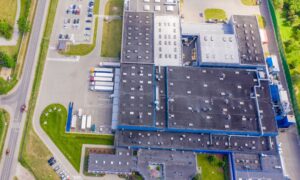Waste is an inevitable part of every human on this planet, and in small or large amounts, every single person is also a waste producer. The production of waste is linearly rising with economic development and living standards; thus, the prediction for the next decades is rather pessimistic.
According to the World Bank, estimates state that by 2050, the world will generate 3.88 billion tonnes (3,880,000,000,000 kilograms!) of waste each year – an alarming increase of 73% from 2020. However, many people and the general public still do not understand the connection between waste management and climate change, which may not be as obvious as when talking, for example, about cars or refineries.
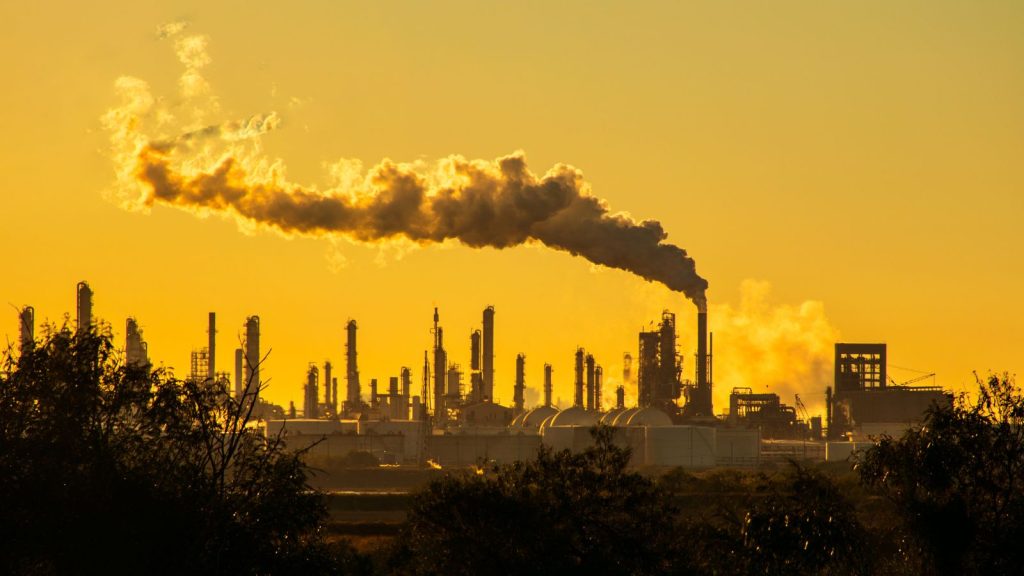
Methane vs. Carbon dioxide
First of all, when speaking about emissions, we should differentiate among the different types of greenhouse gas emissions (GHG). These gases act like a blanket covering our planet, trapping Earth’s radiation and warming it. Speaking about the GHG relevant to waste management, three types are particularly relevant: carbon dioxide (CO2), methane (CH4), and nitrous oxide (N2O).
Out of these three, methane is particularly potent, currently considered to have a global warming potential 25 times that of CO2 when a time horizon of 100 years is considered. If we consider a shorter time frame of 20 years, the global warming potential of methane would be even 73 times higher than that of carbon dioxide according to UNEP. It is stated that methane is responsible for nearly half of the 1-degree Celsius of warming we’ve experienced until today. One alarming prediction is that methane emissions from waste are expected to increase by 13 megatons per year over the next decade alone.
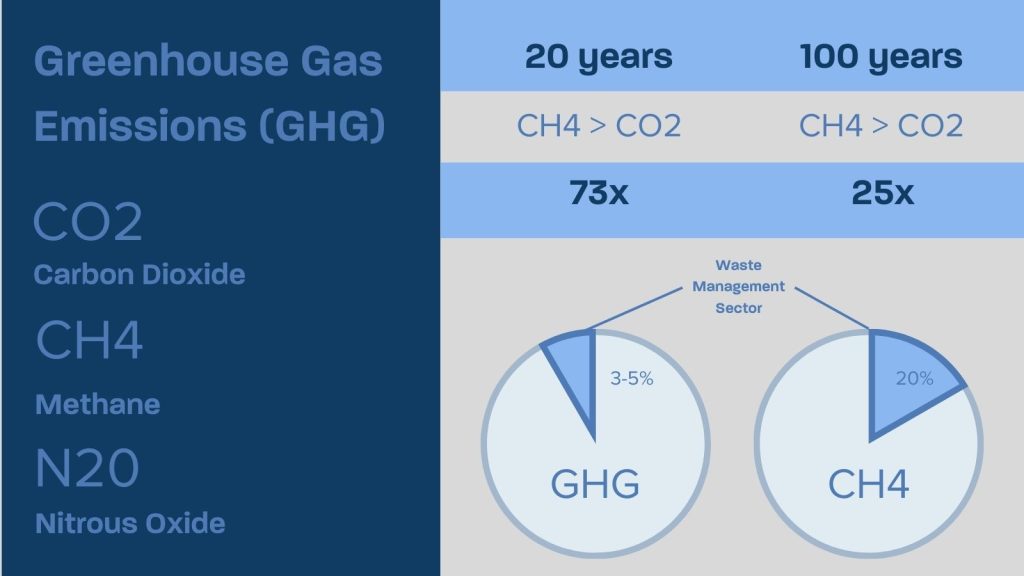
Share of waste among all emissions
When it comes to all GHG emissions, the waste management sector makes a relatively minor contribution on a global scale, estimated at approximately 3-5% of total anthropogenic emissions in 2005. Speaking specifically about methane, waste is one of the three key methane-emitting sectors after agriculture and oil/gas, responsible for about 20% of human-driven methane emissions globally.
What is unique and important here is that the waste sector is in a position to become a major saver of emissions while being a minor source of these emissions because the prevention and recovery of waste could avoid emissions in all other sectors of the economy. A holistic approach to waste management has positive consequences for GHG emissions from the energy, forestry, agriculture, mining, transport, and manufacturing sectors. For illustration, 100 companies are accountable for a staggering 71% of worldwide emissions. A proactive approach to sustainable waste management in the operations of these companies could have a major impact on the amount of emissions created during their internal processes.
Causes of emissions in waste management
The main reasons why waste management can cause emissions and therefore negatively impact the climate can be divided into these categories:
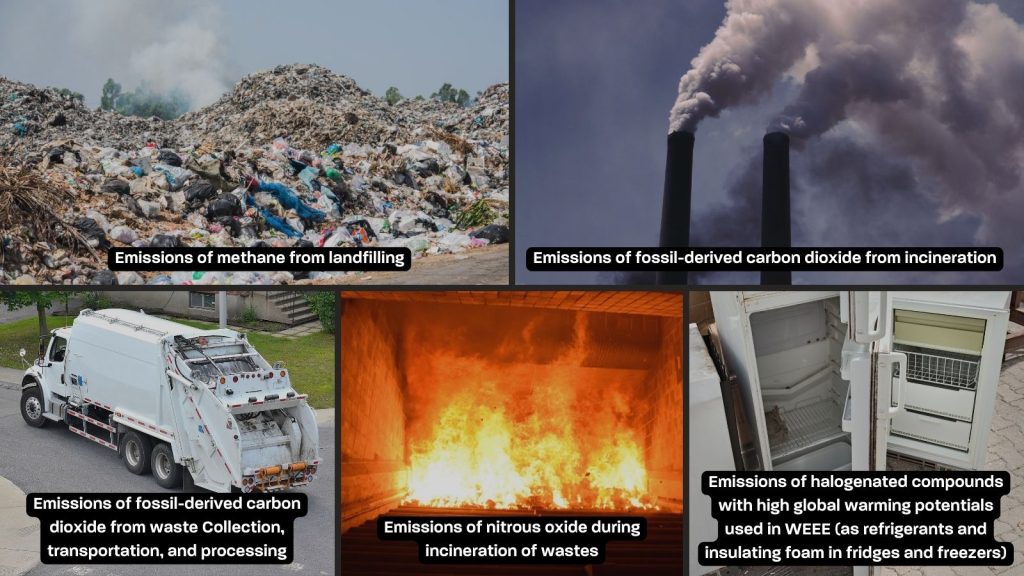
Emissions of methane from landfilling
A landfill is a waste disposal site where disposable materials are sent, presenting a great risk due to the high levels of methane gas and carbon dioxide generated by waste decomposition in these open-air spaces. The solid waste emissions from landfills and dumps represent the absolute majority of methane emissions from the waste sector. Here, organics decay slowly over decades, releasing what is commonly known as landfill gas (LFG), a combination of methane and carbon dioxide. The amount of methane produced by a landfill is primarily based on the amount of organics in the waste stream. Globally, organic waste makes up about 65% of waste generated, with food and green waste comprising the largest share.
Of course, when talking about food waste, it is not possible to apply the standard waste management hierarchy, including reusing and recycling, in which the landfill is the least preferred option. Therefore, a modified version by RMI with two other stages before the landfill could be applicable.
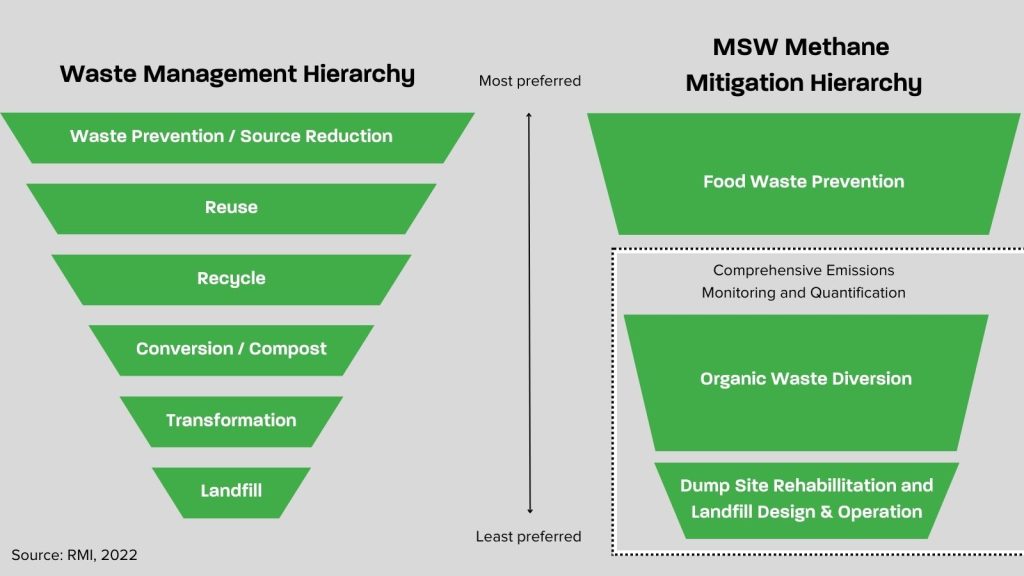
The most preferred option in this hierarchy is food waste prevention, ensuring that food in good condition is not thrown away just like that. An example of that is retailers and supermarkets that are according to the law obliged to get rid of food with surpassed expiration dates. A good example of initiatives preventing such waste could be different food banks directing this food to people in need who could still get used to these products.
Organic waste can be diverted at the source by waste generators like households or restaurants (i.e., keeping a separate bin for food waste in the kitchen) or at a facility designed for separating mixed municipal waste. Source separation straight at the source and not in these facilities is the technically preferred option as it reduces contamination — bits of plastic or glass winding up in the waste — which is significant as uncontaminated waste can be further used, for instance, as compost in agriculture. A leading example globally in the treatment of food waste is South Korea, which managed to reach a 95% recycling rate of its food waste, also thanks to laws and policies including a 2005 ban on landfilling of food and a 2014 weight-based food collection and disposal program.

When there is no other option left and food waste is not diverted and ends up on a landfill, its design and operation are critical to capturing methane generated from organics. Open landfills and dumps, present in much of the developing world, pose human and environmental health and safety risks. Though upfront costs are high, dumps can be redesigned to include environmental control systems, LFG capture systems, or covers that oxidize methane as it is released. Existing sanitary landfills with LFG capture systems can focus on maximizing the collection and use of the generated gas.
Emissions of fossil-derived carbon dioxide from incineration
All our efforts to avoid incineration as the final stage of generated waste stress the importance of recycling materials. Recycling can be described as a process where paper, glass, metals, plastics, textiles, and waste from electrical and electronic equipment are recovered from the waste stream and reprocessed to make secondary materials to minimize the extraction of new resources and alleviate the burden on our environment.
In particular, there is a general global consensus that the climate benefits of waste avoidance and recycling far outweigh the benefits of any waste treatment technology, even where energy is recovered during the process. This fact could be confirmed by various numbers:
- According to Reloop, achieving a 90% collection rate of beverage plastic containers, when expressed in numbers, could result in an annual greenhouse gas reduction equivalent to eliminating 121k cars. A 90% collection rate is set as a 2029 target of the EU directive for all its member states, and it is proven that the most efficient way to achieve this goal is the implementation of a Deposit Refund System (DRS).
- For other materials (glass, ferrous metal, textiles, and aluminum), recycling offers overall net greenhouse gas flux savings of between about 30 (for glass) and 95 (for aluminum) kg CO2 eq/tonne, compared with landfilling untreated waste. For these materials, the benefits are essentially independent of landfill standards and carbon sequestration.
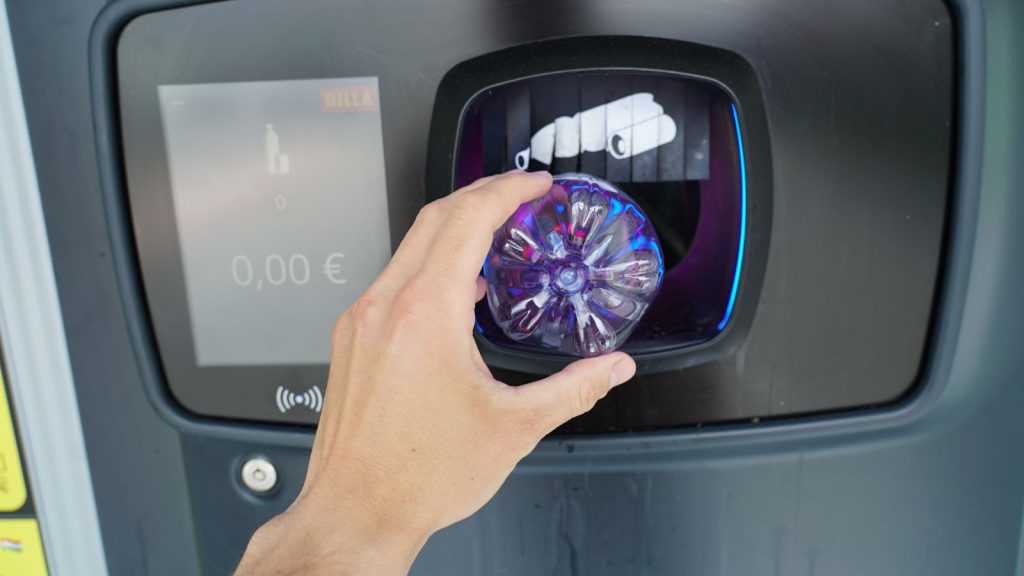
Emissions of fossil-derived carbon dioxide from waste collection, transportation, and processing
Many people connect climate change and waste management through carbon dioxide emissions generated during the collection, coming out of the large waste vehicles that have significantly higher fuel consumption than standard cars. A large number of waste collection companies still operate in a very old-school way, collecting bins with a fixed schedule, for example, once a week. This may result in the collection of empty or half-empty bins and, therefore, in the creation of unnecessary GHG emissions from waste trucks.
The solution for this problem can be technologies like IoT-enabled smart sensors that provide real-time insights and, therefore, not only create optimized collection routes but also help to reduce environmental impact and enhance overall efficiency. Data coming from this technology can bring the power of analytics in identifying patterns, predicting waste generation, and optimizing resource allocation.
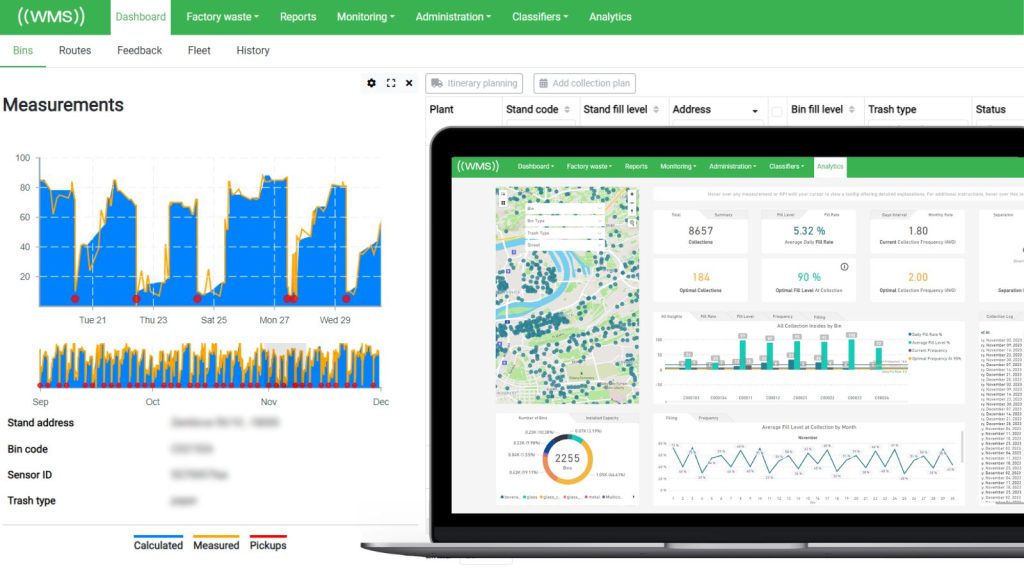
Other Emissions:
- Emissions of nitrous oxide during incineration of wastes
- Emissions of halogenated compounds with high global warming potentials used in WEEE (as refrigerants and insulating foam in fridges and freezers)
In conclusion, the connection between climate change and waste management is undeniable. Of course, the best waste is the one that did not even have a chance to be created, so education about prevention is alpha and omega for citizens worldwide. Although waste prevention is found at the top of the ‘waste management hierarchy,’ it generally receives the least allocation of resources and effort. When waste is already generated, two Rs from Reduce, Reuse, and Recycle can be applied, a principle that again requires a lot of education since childhood. Not everything can be reused, and most commodities cannot be recycled by individuals. That is when modern technologies come into play, for example, LFG capture systems on landfills, data-driven waste collection with remote fill-level sensors, or complex circular economy systems on a nationwide level like the Deposit Return Scheme.
All these emerge as a beacon of hope, offering not just a solution to the environmental challenges posed by improper waste disposal or poor recycling practices but also a pathway to a more sustainable and resilient future. By embracing innovative technologies and adopting eco-friendly solutions, we can collectively work towards mitigating climate change and preserving the planet for future generations.
Sources: Clean Air Task Force, UNEP



